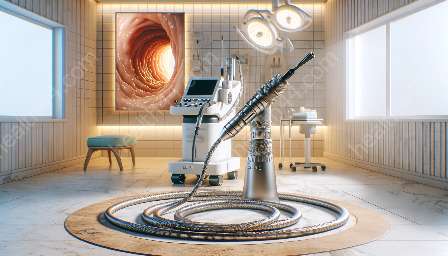Endoscopic cutting and ligating devices are essential tools in modern medical procedures. They are designed to be compatible with endoscopes and play a significant role in the field of medical devices and equipment. In this topic cluster, we will explore the technology behind these devices, their applications, advancements, and impact on medical practices.
Understanding Endoscopic Cutting and Ligating Devices
Endoscopic cutting and ligating devices are used in minimally invasive surgical procedures to cut and seal tissues. They are designed to be used in conjunction with endoscopes, which are medical devices equipped with a camera and light source to visualize internal organs and structures.
By integrating cutting and ligating functions with endoscopic technology, these devices enable surgeons to perform precise and controlled procedures with minimal tissue damage, reduced scarring, and faster recovery times for patients.
Key Features of Endoscopic Cutting and Ligating Devices:
- Compatibility with endoscopes
- Precision cutting and sealing of tissues
- Minimally invasive approach
- Enhanced visualization and control
- Reduced patient recovery time
Applications of Endoscopic Cutting and Ligating Devices
Endoscopic cutting and ligating devices find applications in various medical specialties, including gastroenterology, gynecology, urology, and general surgery. These devices are used in procedures such as:
- Laparoscopic cholecystectomy (gallbladder removal)
- Endoscopic mucosal resection (EMR) in gastroenterology
- Myomectomy in gynecology
- Transurethral resection of the prostate (TURP) in urology
- Endoscopic sinus surgery
- And many more
These devices enable precise tissue manipulation and control, leading to improved surgical outcomes and patient satisfaction. Advancements in endoscopic cutting and ligating technology have expanded the scope of minimally invasive procedures while maintaining or improving efficacy compared to traditional open surgeries.
Integration with Medical Devices and Equipment
Endoscopic cutting and ligating devices are an integral part of modern medical devices and equipment. They are designed to seamlessly integrate with endoscopes, energy sources, and video systems to provide comprehensive solutions for minimally invasive surgeries.
Integration with medical devices and equipment not only enhances the functionality of endoscopic systems but also contributes to the overall advancement of surgical techniques. The compatibility of these devices with existing medical equipment ensures a smooth transition to advanced surgical procedures while maintaining high standards of patient care and safety.
Advancements in Endoscopic Cutting and Ligating Technology
Recent advancements in endoscopic cutting and ligating technology have focused on improving device versatility, precision, and safety. Innovations such as ergonomic designs, enhanced sealing mechanisms, and advanced energy sources have contributed to better outcomes and reduced procedural times.
Furthermore, the integration of advanced imaging and navigation systems with endoscopic devices has facilitated better visualization and control during surgical procedures. These technological advancements have led to the expansion of minimally invasive techniques across a wide range of medical specialties, benefiting both patients and healthcare providers.
Benefits of Endoscopic Cutting and Ligating Devices
The use of endoscopic cutting and ligating devices offers several benefits for patients, surgeons, and healthcare facilities:
- Minimally invasive approach reduces trauma to tissues
- Faster recovery times and shorter hospital stays for patients
- Precise and controlled tissue manipulation
- Enhanced visualization and reduced risk of complications
- Cost-effective and efficient surgical solutions for healthcare facilities
These benefits underscore the importance of endoscopic cutting and ligating devices in modern healthcare, where the emphasis is on delivering excellent clinical outcomes while minimizing patient discomfort and recovery periods.
Conclusion
Endoscopic cutting and ligating devices have revolutionized the field of minimally invasive surgeries. Their compatibility with endoscopes, seamless integration with medical devices and equipment, and continual advancements in technology have significantly impacted the practice of modern medicine.
As healthcare providers continue to embrace minimally invasive approaches, the role of endoscopic cutting and ligating devices will only continue to expand, offering new possibilities for improved patient care and surgical outcomes.


